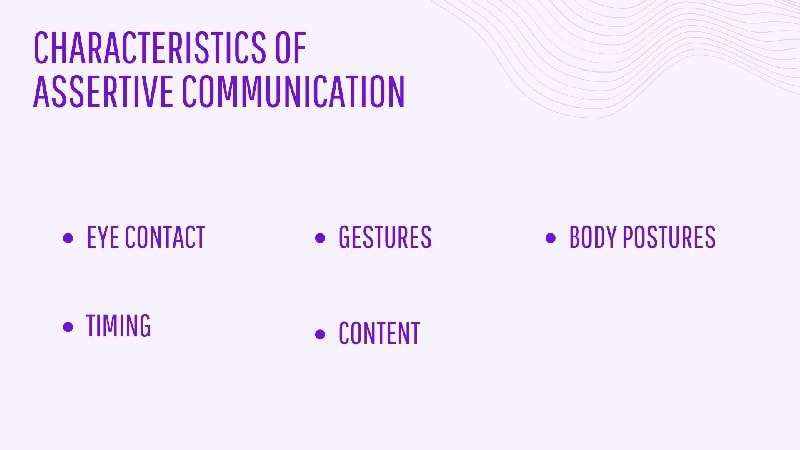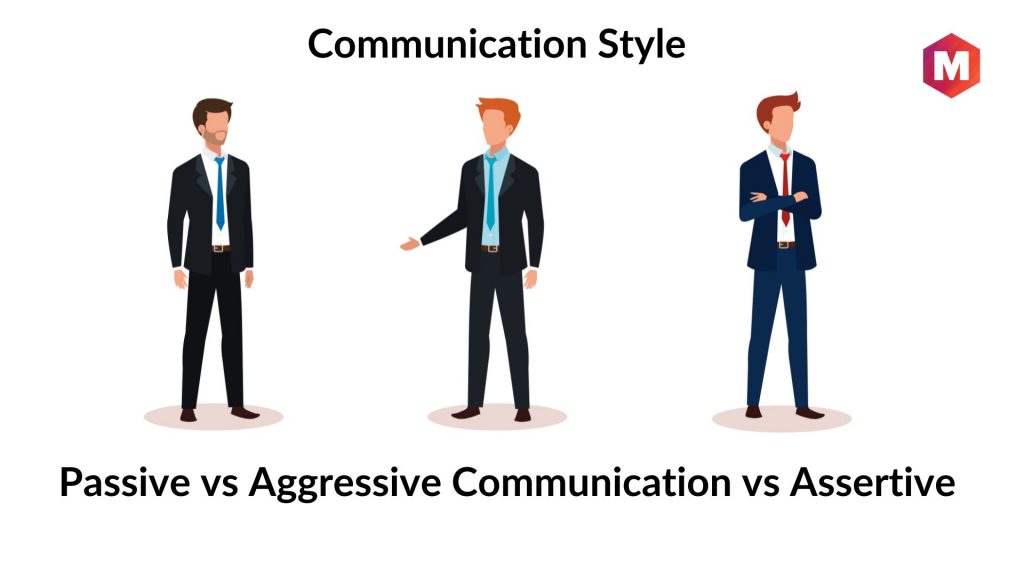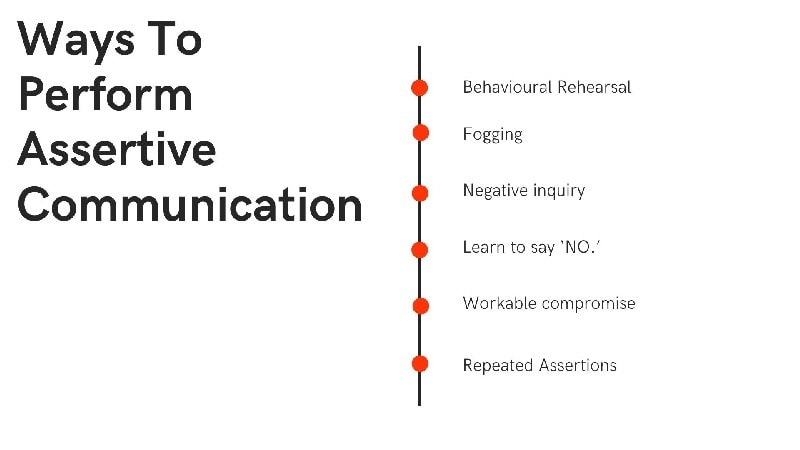Assertive communication is a way to put forward your values without hurting anyone else. It is the best type of communication which helps you to put forward your opinion without being misunderstood by the person in front.
By adept use of the Assertive Communication Skills, you will be able to raise your voice for your rights (and other’s rights) without being aggressive. Such a form of communication is quite useful in reducing stress, drama, and conflicts.
While addressing the power of being more assertive communicator, Doreen Virtue once said-
“Once you have a major success with your assertiveness training, you learn that it’s a much healthier path than being a doormat to the insensitive folks. You gain respect for yourself, have more time for your priorities, and develop authentic and healthier relationships.”
Did you know?
According to the American Psychological Association, assertiveness training can significantly reduce social anxiety and improve self-esteem. By developing assertive communication skills, individuals are better equipped to express their thoughts and needs confidently, leading to healthier and more balanced personal and professional relationships. (Source: American Psychological Association)
Furthermore, a study published in the Journal of Behavioral Therapy and Experimental Psychiatry found that individuals who practiced assertive communication experienced a noticeable decrease in stress levels. This highlights how being assertive not only enhances interpersonal interactions but also contributes positively to one’s mental well-being. (Source: Journal of Behavioral Therapy and Experimental Psychiatry)
But it is not a piece of cake to practise assertive communication in real life so easily.
It would help if you had proper knowledge of it and fair practice to be good at it. So here we are going to talk about assertive communication and how to improve it for your good. Let us first understand what it is-
Table of Contents
What is Assertive Communication?
Assertive communication is something that leads to a win-win situation.
It is all about putting your views while respecting other’s opinions and beliefs. It is taking a stand for your own while not undermining the needs of the other.
It is the balance between aggressive behavior and passive communication styles.
The aggressive form of communication hurts feelings and fractures relations while on the other hand, a passive form of communication leads to stress, the negative emotions to feel, and resentment.
With Assertive communication, you will be able to resolve both of these issues with quite ease and effectiveness.
So, all in all, assertive communication training enables you to demand respect without being disrespectful in any way.
Importance of Assertive Communication Style
Assertive communication style has the significance of its own. Following are some of them:
- Assertive response boosts up your confidence level.
- It helps you achieve your goals without hurting others.
- It makes you a better stress-free person with high self-esteem.
- Assertive behavior leads to clear, open and direct communication. It prevents misunderstanding between you and others.
- It makes you trustworthy to others as you respect others’ feelings.
- It creates a good relationship with others as you take a count on others’ beliefs.
- It helps you achieve your goals in the right way.
- It leads to the development of a mutually respectful relationship.
- It reduces the stresses of your life and anxiety and helps you keep calm.
- It does not let you hurt each other.
Different Benefits of Assertive Communication
The first question that comes in mind when we first tell you that you should start practicing assertive communication is why I should practice it?
And the answer to your question is for your good and a better future for you.
Assertive communication leads to more assertiveness, better communication and less misunderstanding in life.
It is the best-balanced way to communicate with others. So here are some benefits that can be your reason to practice assertive communication.
1) You get a Better communication
Assertive communication helps you get better communication without the risk of being misunderstood. It improves your managing skills too.
2) Less stress develops in your life
As you stay calm with your stress management problems, it helps you stay less stressed about life. You become more relaxed and composed through this.
3) You gain more trust from others
You become more trustworthy to others due to your respect for others’ beliefs.
4) You become more confident ultimately
As you learn to express your feelings and needs, you become more confident and boost your self-esteem.
5) Assertive communication creates a respectful environment where everyone grows and matures in
When assertive communication is practiced, it leads to the development of positive relationships and mutual respect. It the assertive form of communication, everyone strives to contribute to the improvement of ideas, and feedbacks are also positively considered.
6) Assertive communication lets you feel good about ourselves and others
When it comes to assertive communication, self-esteem is one of the most critical factors, as using such behavior as a form of communication rates self-esteem quite high. When you put forward your voice for your and others’ rights, it suggests that you value your opinion and you do let others manipulate you.
Now, in the next section, we will be covering some of the characteristics of assertive communication-
What are the Notable Characteristics of Assertive Communication
Specific characteristics make assertive communicator behavior different from the aggressive and passive communication. Let’s see what six of the essential features.
Eye contact
This leads you to talk to the opposite person directly with a clear vision and demonstrates sincerity
Gestures
Positive body language increases the listener’s interest also. It helps to communicate assertively draw the opposite person’s attention.
Body postures
A confident upright body posture helps the expression of confidence and self-esteem.
Voice
Right toning and clear voice pull in the attention of the opposite person. And it helps to express your views clearly.
Timing
A proper judgment to point out the timing helps to express the views and other person’s motives adequately.
Content
Incorporating the right content in your discussion/debate and putting that forward at the right time is quite critical in assertive communication.
In addition to these characteristics, three Cs play a significant role in assertive communication-
3 Cs of assertive communication
There are main three main points of assertive communication that defines it.
These three points collectively determine what assertive communication is.
Let’s read the following and see what these three mean more broadly.
-
Controlled: it is about the expression of your emotions in a calm and composed manner without getting emotional.
-
Clear: this keyword means you have to deliver your message in a clear form without any ambiguous meaning so that people do not misunderstand it.
-
Confidence: it is about believing in yourself that you can handle your situation.
Here is a video by Marketing91 on Assertive Communication.
Passive vs Aggressive Communication vs Assertive Communication Style
Assertive, passive and aggressive communication are three different ways of communicating.
Passive communication is when you don’t speak up for yourself or what you want. You let others take control over the conversation, and you don’t say anything about your own feelings or desires. This can lead to feeling frustrated and disappointed in yourself because you feel like you’re not being true to yourself or standing up for what’s right.
Aggressive communication is when someone tries to get their way by being forceful and aggressive response with their actions or words. They might yell at a person they’re upset with, or they might insult them in an attempt to get what they want. This type of aggressive behavior can make other people feel angry and upset because they feel like they can’t have a real conversation with someone who acts this way toward them.
Assertive communication is when both people involved in the situation feel respected by each other’s words and actions. Both parties talk about what they want from each other—and if those things aren’t compatible then there are compromises made so that everyone gets something out of it—but both sides also listen to each other carefully so that nobody feels like their needs aren’t being heard or taken into consideration before decisions are made together as equals.”
Ways to perform Assertive Communication
As tricky as it can be to get a better hold of assertive communication, you may find different ways to improve your assertive communication. With the following skills and a little practice, you can master the assertive communication.
1. Behavioural Rehearsal
It is mainly about how you look and sound. Behavior helps in expressing their feelings better. A confident upright posture with a clear and loud voice will always attract more attention from the opposite person. Using ‘I’ statements will help you to have negative feelings for your betterment. It improves your behavior towards assertive communication.
2. Fogging
This allows you to accept criticism from others positively. It will help you improve yourself. It helps you to understand that there may be some aspects to improve yourself too. It enables you to get yourself better from without getting any anxiety and defensiveness.
3. Negative inquiry
This technique allows you to check for the comments you get. You check the comments and judge it they are informative to accept them. And if they are manipulative then reject it. Clarify your thoughts and make the criticism into direct and clear requests to help yourself.
4. Learn to say ‘NO.’
You need to say ‘NO’ certain things. There you should learn to avoid things prioritizing your work. But saying ‘NO’ may be tricky enough. It is better to practice role-playing with your colleagues.
5. Workable compromise
Assertive communication teaches us one more thing that it is not harmful to accept what you cannot change about others. It is essential to understand that you cannot improve everything about what others think. It is better to compromise until your personal feelings for the compromise.
6. Repeated Assertions
With the help of this technique of assertive communication, you will be able to stay comfortable in ignoring different types of verbal traps used for manipulating you. It is also quite useful in front of irrelevant logics and augmentative baiting. In this technique, you need to stick to your point with calm repletion and staying focussed. Let us understand this with an example-
“I would want to inform you about some of our services.”
“No thank you, I am occupied and not interested.”
“I comprise a wide range of services to offer you.”
“That may be true, but I’m not available to listen right now.”
“Is there someone else here who would like these services?”
“I don’t know about anyone looking for these services.”
“Okay, would you mind taking this brochure and thinking about it?”
“Yes, I will take your brochure.”
“Thank you.”
“You’re welcome.”
So, this is how you can use assertive communication successfully. Let us now go through some of the critical tips of assertive communication-
How to master Assertive Communication Skills
1. Have the right tone
While having assertive communication, you must opt for the right toning skills when you put forward your opinion.
In communication, the tone can make or break a situation, and that is why being aware of a calm and relaxed tone that should be right for that situation and available audiences is very crucial here.
Having a tone of voice that sounds irritated, exhausted or aggress is a big NO for effective assertive communication.
2. Have will to continue the discussion to find the solution
A discussion or conversation can only productive and constructive if it reaches the final solution.
Assertive communication ensures this, but you need to have the will to continue the discussion positively and respectfully, so everyone likes to participate in the conversation.
Walking away from a discussion is the passive way of communication while being quite loud and dominating is an aggressive form of communication.
Listening to others accurately, putting forward different possible options and continuing discussing in which both the parties feel respectful are integral parts of assertive communication.
3. Pay heed upon the nonverbal communication
Gesture, posture, assertive body language, reactions, listening cues, etc. play significant roles in assertive communication, and you need to be mindful of those as well.
Such gestures and postures should never translate into either passive behavior or aggressive forms of communication.
With direct eye contact in a conversation, you will stay focused in the assertive form. Even in some of the cases, your nonverbal communication becomes more critical in comparison to the verbal communication.
Final Thoughts about Assertive Communication!
Getting used to in Assertive communication can be both tricky and challenging, but with the help of the techniques mentioned above, you will, for sure be able to incorporate these skills.
Here we hope our article has helped you enough to improve your assertive communication. Thank you for going through the article, and we hope you visit us soon again.
In case of any doubts, feel free to ask us in the comments.
What according to you, are the most important benefits of using assertive communication in discussion or debate? Do you have any experience with such sorts of effective communication before?
Share with us and make this post the best place to master assertive communication skills.
Liked this post? Check out the complete series on Communication





